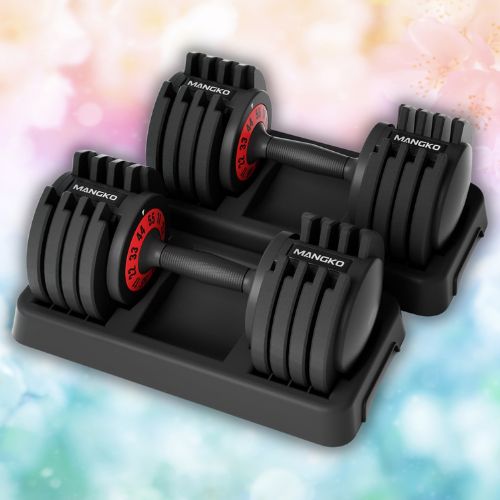Building strong, sculpted shoulders at home can often feel challenging without the right guidance. This at home dumbbell shoulder workout will revolutionize your shoulder training and hopefully give you the boulder shoulders you’ve been working for.
Key Boulder Shoulder Takeaways
- Engage all three deltoid muscles – anterior, medial, and posterior – with exercises like dumbbell frontal raises, lateral raises, rear delt flies, and presses for comprehensive shoulder strength.
- Use time – based sets focusing on quality execution to enhance muscle activation; this method is adaptable across fitness levels whether using light or heavy dumbbells.
- Incorporate a variety of movements in your workout routine with just a pair of dumbbells to prevent muscle imbalances and strengthen the shoulders for better performance in compound upper body exercises.
- Progress by gradually increasing rounds over time as strength and endurance improve—aiming for 3 – 4 complete rounds per workout session to achieve significant results.

Dumbbells Perfect for Home Workouts
Custom Weight at home dumbbells
Importance of a Comprehensive Shoulder Workout
A comprehensive shoulder workout is pivotal for building symmetrical strength and avoiding imbalances that can lead to injuries. By focusing on the anterior, medial, and posterior deltoids, you’re not just sculpting a robust upper body; you’re laying a foundation for enhanced performance in various strength exercises and everyday activities.
Targeting all three deltoid muscles
To build a well-rounded shoulder, you’ll want to hit each section of your deltoids: the front (anterior), the middle (medial), and the back (posterior). These muscles play a key role not just in how your shoulders look, but also in functional movements and overall stability.
For instance, while shoulder presses powerfully engage the anterior delts, they don’t fully activate the rear or lateral sections.
This is where specific exercises come into play. Dumbbell lateral raises are fantastic for stressing those medial deltoid fibers that contribute to an impressive upper body width. And don’t overlook those rear delts; isolation moves like dumbbell flyes target this often-neglected area, essential for achieving muscle balance and preventing injury.
Preventing muscle imbalance and injury
Keeping your shoulder muscles strong and balanced is essential for avoiding injuries. Focusing on all three deltoid muscles – the anterior, medial, and rear – ensures that each area gets enough attention during your workout routine.
When these muscles are uniformly developed, they work together more effectively to stabilize the shoulder joint. This kind of balance is crucial because it helps prevent one muscle group from becoming too dominant over others, which can lead to strain or injury.
To maintain this crucial muscle equilibrium, incorporate exercises like dumbbell front raises, lateral raises, and rear delt flies into your regimen. These movements target the different areas of the shoulders for comprehensive development.
Using dumbbells allows for a greater range of motion compared to barbells or machines, engaging stabilizing rotator cuff muscles as you lift. Proper form and controlled execution further reduce the risk of injuring these sensitive joints; slow down during reps to ensure precision instead of rushing through sets with heavy weights.
Contributing to strength for upper body compound exercises
Building upper body strength is crucial, and a comprehensive shoulder workout does more than just sculpt your deltoids. It sets the stage for heavier lifts in compound exercises like bench presses, deadlifts, and pull-ups.
Training your shoulders helps improve stability and power which are essential for performing these multi-joint movements effectively. You work on muscles that support the pectoralis major, latissimus dorsi, triceps, and even your core.
This means that by leveling up your shoulder game with exercises such as dumbbell presses and lateral raises, you’re directly enhancing performance across a wide range of activities.
A strong set of shoulders doesn’t just look impressive; it’s foundational for upper body function. By engaging in resistance training focused on all three deltoid muscles—frontal, medial, rear—you lay down the groundwork for better posture and movement mechanics during complex routines.
Not only will these gains translate into lifting heavier weights in the gym but also they improve day-to-day tasks requiring pushing or pulling actions. Emphasize shoulder workouts to unlock new levels of overall strength and capability that ripple through every upper body challenge you tackle.
Enhancing overall fitness components
Working on your shoulders isn’t just about building muscle; it’s about boosting overall fitness too. By focusing on a comprehensive shoulder routine, you can improve vital components like form and balance.
These elements are key to executing movements with precision, whether you’re lifting weights or carrying groceries. A strong set of deltoids also supports proper technique during upper body compound exercises – think push-ups and chin-ups – enhancing the effectiveness of your workouts.
Consistently training all three deltoid muscles ensures that no aspect of your shoulder strength is left behind. This holistic approach reduces the risk of muscle imbalances and injuries, paving the way for a more resilient physique.
It sharpens your body awareness as well, which translates into better posture and movement in daily activities. With each repetition tailored to activate these targeted areas, you’re not only sculpting powerful shoulders but fortifying your body’s overall stability and coordination for sports, tasks at home, or any physical challenge life throws at you.
Workout Format
Our home shoulder workout is designed with time-based sets that prioritize precise technique and can be easily adapted to any fitness level, ensuring you get the most out of your training session – keep reading to discover how this approach can transform your routine.
Time-based sets for focus on execution quality
Shifting focus from the number of reps to the quality of each movement, time-based sets are a game changer in this shoulder workout. Grab your dumbbells and prepare for 45 seconds of concentrated work per exercise, followed by a brief 15-second pause to catch your breath.
This approach ensures that every raise, press, and fly is executed with precision – forming picture-perfect motions that activate your front delts, side delts, and rear deltoids efficiently.
This method doesn’t just cater to muscle growth; it adapts seamlessly across all fitness levels. Whether you’re lifting light weights or challenging yourself with heavier ones, these time-gated intervals allow you to adjust intensity at your own pace.
Suitable for any fitness level
Transitioning from the emphasis on execution quality, our home shoulder workout is designed to be inclusive, catering to all who seek to strengthen their shoulders regardless of experience or fitness level.
Beginners can start with lighter weights and focus on mastering the form without feeling overwhelmed by a high number of reps. For those more advanced, adjustable dumbbells provide the flexibility to increase resistance and challenge muscles further.
This program sidesteps one-size-fits-all routines and instead offers scalable exercises that are easily adapted. Your individual needs will guide your workout intensity; if you’re recovering from an injury or just starting out, lower weights or shorter time sets might suit you best.
Required Equipment
Required Equipment: All you need to unlock a full spectrum of shoulder workouts at home is a set of dumbbells. If you have a bench this is helpful but certainly, not required!

Dumbbells Perfect for Home Workouts
Custom Weight at home dumbbells
A pair of dumbbells
Grab your dumbbells because they are about to become your go-to tool for building those shoulder muscles right at home. Whether you’re a beginner or more experienced, these free weights are adjustable to match your strength level, ensuring that muscle activation and growth follow every rep.
From the anterior deltoid through to the lateral and rear delts, dumbbells provide a full range of exercises for all three muscle groups. They create just the resistance you need for effective isolation exercises without overcomplicating things.
Using dumbbells also means versatility in your workout routine; switch from seated shoulder presses to lateral raises or front raises with ease. Each exercise engages different parts of the shoulders, promoting balanced development and helping prevent injuries that might arise from muscle imbalances.
Exercise Breakdown
In our exercise breakdown, we delve into dynamic movements tailored to sculpting your shoulders with just dumbbells; discover the full routine that awaits to elevate your home workout regimen.
Dumbbell alternating frontal raises
Dumbbell alternating frontal raises are key for sculpting the shoulder muscles, particularly targeting the frontal delts. They require a pair of dumbbells and a commitment to form precision.
Begin with your feet planted about shoulder-width apart and engage your core to maintain balance throughout the exercise. Grasp the weights firmly in each hand at thigh level.
To execute this move, lift one dumbbell straight up in front of you while keeping your arm slightly bent and then lower it back down with control as you raise the other arm. This alternation ensures continuous tension on your deltoids, building endurance and strength across both shoulders equally.
Each rep should be performed deliberately, honing focus on muscle contraction and stability. Aim to sustain this exercise for 45 seconds to work toward strong, defined upper arms that support functional movement in everyday activities as well as athletic endeavors.
Dumbbell lateral raises
Get ready to target those lateral deltoids with the dumbbell lateral raise, an essential move for building shoulder width and strength. Begin by gripping a pair of dumbbells firmly at your sides while standing with feet shoulder-width apart.
This stance provides stability as you focus on isolating the shoulders during the exercise.
Lift the weights out to your sides with control, keeping a slight bend in your elbows to protect your joints. The goal is to achieve a full range of motion without compromising form – imagine reaching out rather than just lifting up.
Aim for 45 seconds of continuous movement, maintaining tension on those medial delts throughout each rep. Between sets, engage in active rest; this keeps muscles warm and prepared for the next round without letting them completely relax.
Dumbbell skis
Moving from dumbbell lateral raises to another effective shoulder exercise, let’s dive into dumbbell skis. This movement zeroes in on your rear deltoids, a crucial muscle group for that rounded shoulder look and essential for balanced upper body strength.
Start by leaning forward with a straight back, grasping the dumbbells firmly with palms facing inward. Now envision yourself as a skier – swing the weights slightly backward at hip level then lift them up like you’re gliding along snowy trails.
This exercise isn’t just about aesthetics; it plays a pivotal role in maintaining healthy shoulders by engaging muscles that often get neglected. Dumbbell skis can be modified to suit various fitness levels by adjusting the pace or changing up the weight of the dumbbells used.
Keep this movement controlled; it’s not about speed but rather focusing on form to effectively target those all-important lats and rear delts.
Dumbbell press
After powering through dumbbell skis, shift your focus to the dumbbell press—an essential exercise for sculpting your shoulders. Stand upright, clutching a dumbbell in each hand at shoulder level.
Ensure your core is engaged as you push the weights directly above your head until your arms fully extend. This powerhouse move zeroes in on your frontal and medial deltoids, which are crucial for building strength and achieving that well-rounded shoulder look.
Lower the dumbbells back to the starting position with control—don’t let gravity do the work. Repeat these presses for reps, maintaining a steady pace without compromising form. Each lift should feel challenging yet fluid, allowing you to fortify those key muscle groups while safeguarding against injury.
Rear delt flies
Rear delt flies are a powerhouse move for hitting those often-neglected rear deltoid muscles. They require precision and control; start by leaning forward slightly, with knees soft and dumbbells in hand.
Engage your core as you lift the weights outward, keeping a slight bend in the elbows. Imagine you’re spreading your wings to fly—this will help maintain the tension where it’s needed without cheating the movement.
With only 45 seconds per set, focus on form rather than speed. Lower the weights back down with that same controlled motion after each rep, ensuring you’re not letting gravity do the work for you.
This deliberate action maximizes muscle engagement and prevents momentum from stealing your gains. Each lift strengthens those crucial shoulder stabilizers that protect against injury and enhance overall upper body strength.
Elevated pike push-ups
Elevated pike push-ups turn the heat up on your shoulder workout, driving focus onto your frontal and medial deltoids. Begin in a classic push-up stance, then walk your feet forward and elevate your hips to create an inverted V shape with your body.
Your arms should extend directly below you, bearing the weight of your upper body as you lower yourself towards the ground.
Challenge yourself by altering the difficulty level; elevated pike push-ups can be intensified or modified to fit any fitness stage. Push through each rep, keeping a steady pace while maintaining tight core engagement throughout.
High side plank raises
High side plank raises are a dynamic exercise that not only strengthen your shoulders but also engage and fortify your core. Start by positioning yourself in a side plank, ensuring your body forms a straight line from head to toe.
Your supporting hand should be placed solidly on the floor while your other arm can either reach toward the ceiling or rest on your hip for balance. From this position, you will lower your hips towards the floor slightly and then raise them back up into the starting position.
Keep each lift controlled and deliberate to maintain proper form throughout.
Perform high side plank raises for 22 seconds on one side before switching to work the opposite shoulder and core muscles equally. This time-based approach allows you to concentrate fully on executing each movement with quality over quantity, making it suitable for any fitness level.
As you raise and lower your body, focus on keeping tension in both shoulders—this isn’t just an abdominal challenge; it’s an all-encompassing upper-body builder heading into rear delt flies next in our workout sequence.
Workout Completion and Progression
To achieve the full benefits of this shoulder workout, aim to gradually increase your exercise rounds, ensuring that each session pushes you closer to your fitness goals—discover more by diving into our detailed guide.
Aim for 3-4 rounds for a complete workout
Completing 3-4 rounds of the shoulder exercises, including dumbbell presses and rear delt raises, will give you a solid workout that challenges your muscles effectively. Push through these repetitions with focus and control, ensuring every muscle fiber gets attention.
As you progress over time, increasing the number of rounds gradually can lead to more significant strength gains and muscular endurance.
Charge into each exercise with determination and consistency; this is vital for muscle growth and improvement in overall fitness. Mix up movements like arm circles and lateral raises to hit all parts of your shoulders.
Increase rounds over time for enhanced benefits
As you dive into your shoulder workout, starting with 3-4 rounds is a solid foundation. It’s essential to know that as your shoulders grow stronger and more resilient, boosting the number of rounds can lead to even greater muscle growth and endurance.
Think of each additional round as another step up in your fitness journey, pushing your limits and expanding what you’re capable of achieving.
Consider this strategy a way to continuously challenge your body. Gradually increasing the intensity ensures that muscles don’t plateau but keep improving through stress adaptation.
More rounds mean more reps; it means putting those dumbbells, kettlebells, or resistance bands to work for longer periods which translates into better stamina during push-ups and increases in overall upper-body strength including internal rotation and shoulder flexion.
Conclusion
Grab your dumbbells and let’s make those shoulders unstoppable! Every rep brings you closer to a well-defined, stronger upper body. Adjust the workout to match your fitness level and watch as your form and technique improve with each session.

Dumbbells Perfect for Home Workouts
Custom Weight at home dumbbells
FAQs
1. What shoulder exercises can I do at home with dumbbells?
You can strengthen your shoulders at home by doing a variety of exercises, such as bicep curls, overhead presses, and front raises using dumbbells. These workouts target different muscles in the shoulders for a comprehensive routine.
2. How many reps should I aim for in a shoulder workout?
For a balanced workout, you might start with 8-12 reps per exercise. This range is ideal for building strength and muscle endurance when you’re working out your shoulders.
3. Can push-ups be part of my shoulder workout routine?
Yes! Push-ups are an effective exercise that targets not only your chest but also engages your shoulders and triceps. They’re perfect to include in your upper-body workout sessions.
4. Do I need special equipment like an incline bench to train my shoulders?
While an incline bench can add variety to your workouts, it’s not necessary for a productive shoulder routine. Dumbbells alone offer ample opportunity to perform effective exercises that build strong shoulders right from the comfort of home.




Leave a Reply